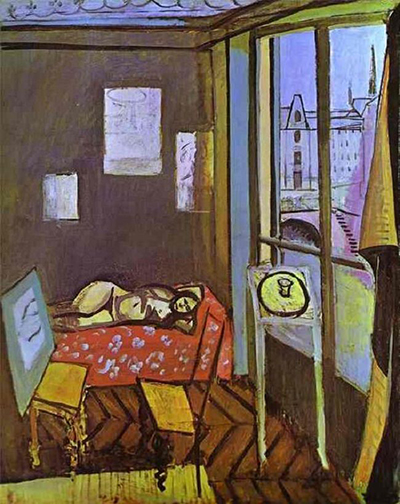Henri Matisse, a French artist, painted this drawing in 1916. With a combination of abstract and traditional styles, Matisse might have painted the Studio Quai Saint Michel painting to respond to the prevailing World War I. According to its first owner, this was a tricky portrait to live with and understand.
This canvas by the French artist boasts some of the common themes. The painting incorporates the indoor scene's hard pattern lines, the arc of the bridge and model curves with outdoor geometric buildings. Henri regularly painted nude canvases, and unlike in most of his other canvases, this picture contains facial features which hints at a much more intimate relationship. Henri's empty chair and the easel’s half-painted picture probably suggest that Matisse has briefly left the room.
Studio Quai Saint Michel is part of the drawings he painted in his rented studio. The windows of the studio offered an exceptional view of the Notre Dame Cathedral and overlooking the Seine. In this unique canvas, Henri has provided an outstanding view of Sainte Chappelle and the Palais du Justice. The painting's thin layers reveal several lines that give viewers insight into Henri’s working process. What's more, Henri has portrayed several traditional motifs throughout the room. Some of these motifs include the reclining nude, Matisse’s studio, painting within a painting and a still life.
We can say that Henri has drastically simplified the objects and warped the perception to make them seem flattened against the drawing plane. In the end, this gives the motifs a modern spin. As mentioned earlier, Henri includes abstract and representational styles in this painting that represents the themes of his studio, his model and open window. With its simplified horizontal and vertical architectural elements, this drawing shows Henri's studio at 19 Quai Saint Michel in the centre of Paris.
In addition, it indicates that Henri drew the painting during the early spring or the late winter months of World War I. Laurette, Henri's favourite model at the time, is seen reclining on the couch. The shadowed areas above Laurette may be showing some signs of reworking. The shadow areas in the lower portion of the window depict that Matisse attempted the balcony grillwork but discarded it later. Henri laboured over the position and size of the three works positioned on the wall behind the model.
One of the four related drawings of this studio is implied by the propped image of the chair that plays the role of an easel. According to Henri Matisse, the window’s wall doesn’t create two different worlds, while space is a single unity from the horizon.




